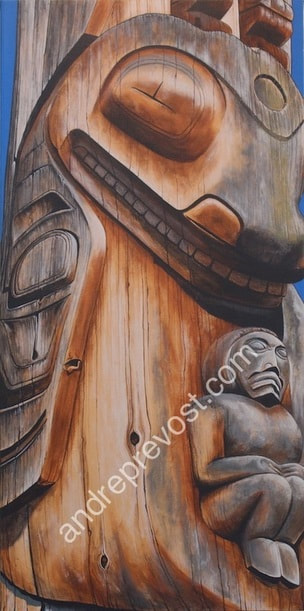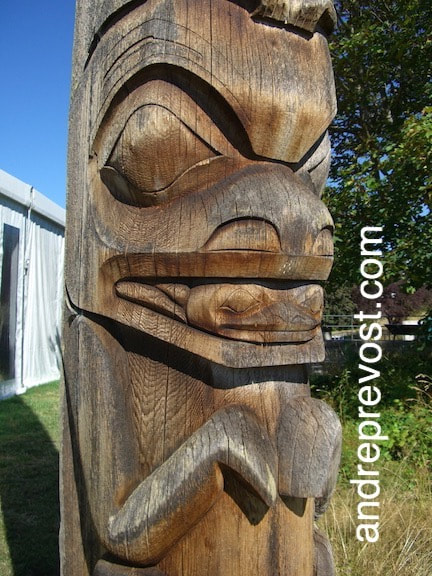|
Killer Whale Totem, 2014 18” x 36” x 1.5” From the ‘Running Wolf Totem Pole’, which tells the origin of the first Gitksan people on the Skeena River. The pole raising was on August 24, 1980 at the Museum of Anthropology, with a large contingent of Gitsan attending. UBC MOA Carved by Walter Harris, a ‘Ksan carver, and family, Richard, Doreen and Rodney. The Nanasimget story: ‘The killer whale is abducting a woman, wife of Nansimget, (whose pursuing husband is depicted lower on the pole).’ After completing the Sentinels painting, I felt the Running Wolf Totem Pole beckoning once again. I had focused on two sections by now (The Frog and the Mosquito). I loved the story behind the other section of the Killer Whale. I also really liked its patina, and thought it could be a great pair to the Mosquito painting if someone was so inclined. As I work through the series, practicality is also present, in exploring with options that art buyers might be considering. The Journey is indeed one of discovery but if this artist has no sales in the process to maintain housing and food on the table for my son and I, then being in my studio becomes very difficult. So I settled on a 18” x 36” canvas. You can see the physical connection to the Mosquito feet just above the Killer Whale’s head. The gray patina was less pronounced on this section and with the deeper carving for its torso, there was more bright cedar catching the bright sunny day when I was there. The carved contours were rounder and the soft cracking followed the ebb and flow of the surface. As two paintings never come out the same, even when you are doing another copy, the shading in the pectoral fin has more of a dry brush effect (even though I use my fingers) and the inset ‘Ovoid’ and ‘U’ patterns are deeper. There are a number of interesting carved details that took all of my skill and observation. Each carved shape/line reacts and changes differently as shadows or highlights: ~ around the upper eye and to the blowhole on its forehead, ~ the bottom of the Mosquito’s wing, ~ the inset carving around the cheek and along the lower jaw. There were numerous layers required in developing the multi-colored patinas and thin mosses on the whale’s snout and the very smooth surface of the ovoid protruding eye. It is very much a two steps forward and 1 step back process. If I’ve gone too far with developing a colour, I am able to lightly work in some of the earlier undertones that I lost. This can’t be rushed. What do I see in the original photograph? Is that what I see on the canvas? If not, why! The reflective glow onto the mouth and teeth is another case in point. It takes successive watery glazes of colour to get the shading just right and differentiating between the surfaces directly in the sunlight and those reflecting the light off the chest of the whale. The last finicky detail was the woman on the whale’s chest. Her carving was very gentle and simple in form. The wood grains or fine cracking in the carving are very subtle, and those that could be seen, all had to conform to the carved shape. It gets tricky at times because a wood grain in a deeply chiseled surface will often not follow the path you assume. You need to visualize the negative space that was removed. For example, the wood grain of the upper arm may not necessarily be the same one that you see on the upper thigh. Also, with the simple form of the carved seated woman, it was tempting to use the same technique as on the rest of the totem. But that wasn’t on the carved woman. Her patinas were very gentle on the smooth carved surfaces, seeming so blended in comparison to the whale’s chest right next to her. When in doubt, I stick with what the original is telling me, for that moment in its timeline. I was pleased with catching the warm cedar bright spots from the sun on the whale’s eye, its lower cheek and nostril, the top of the pectoral fin, its chest, and at the Mosquito’s feet. Another note is the pectoral fin which is seen on the far right next to the woman. It is nowhere as refined as the pectoral fin on the left. It isn’t. Being on the side which is constantly exposed to the sun, the wood degrades much faster. As an example, I’ve attached a picture of the Frog section from the north side of the totem (the angle I used for the Frog painting), and the extremely sharp contrast of the Frog’s face facing south. Amazing on how these two images are in fact two halves of the same totem. * See images
0 Comments
Leave a Reply. |
Archives
November 2020
|







 RSS Feed
RSS Feed